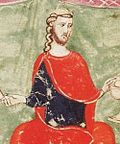Top Qs
Timeline
Chat
Perspective
Simone Chiaramonte
Sicilian nobleman and fourth Count of Modica From Wikipedia, the free encyclopedia
Remove ads
Simone Chiaramonte (c. 1325[a] — d. 1357[b]) was a Sicilian noble of the Chiaramonte family, count of Chiaramonte and count of Modica. In 1353 he married Venezia Palizzi at Messina in an unsuccessful attempt to reconcile the rival Chiaramonte and Palizzi; he died at Messina in circumstances described as mysterious. He left no heirs.
Remove ads
Origins and family
Simone was the only son of Manfredi II Chiaramonte, count of Modica, and Mattia d’Aragona, a natural descendant of King Peter I of Sicily.[1] On his father’s side he belonged to the senior Chiaramonte line: Manfredi II was the son of Giovanni I Chiaramonte (il Vecchio) and Lucca Palizzi, making Simone’s paternal grandmother a member of the rival Palizzi clan.[1][4]
Simone grew up within the Chiaramonte family’s estates centred on Palermo—where the family seat, the Steri, symbolised their dominance—and on their southeastern Sicilian holdings around Modica (including Ragusa, Scicli and Chiaramonte).[1][4]
Remove ads
Career
Summarize
Perspective
Context — Rulers and powers in Simone’s lifetime
After the Sicilian Vespers (1282) the island ("Kingdom of Sicily" or "Trinacria") and the mainland ("Kingdom of Naples") were ruled by rival dynasties. Simone’s brief career fell amid continued tension between the baronial "Latin" and "Catalan" factions.[1]
Sicily (Aragonese dynasty):
- Louis (r. 1342–1355)
- Frederick IV (r. 1355–1377)
Naples (Angevin line):
- Joanna I (r. 1343–1381)
On 15 September 1342, at the beginning of King Louis’s reign, Simone was dubbed knight and invested as count of Chiaramonte (modern Chiaramonte Gulfi).[1]
Simone first came to prominence during the revolt in Palermo in January 1351. The city, hostile to his father’s dominance as head of the Latin faction, rose against him. Reinforcements from Caccamo under Simone and his cousin Manfredi III Chiaramonte entered Palermo on 25 January and, together with loyalist forces, brutally suppressed the uprising.[1] Contemporary accounts stress the severity of the repression, which reinforced the Chiaramonte hold on Palermo but deepened the factional divisions within Sicily.[1]
After the death of his father in late 1353, Simone inherited the family’s leading position. On 15 December that year he was formally invested as count of Modica, adding to his earlier title of count of Chiaramonte.[1]
Remove ads
Family life
In November 1353 Simone married Venezia Palizzi, daughter of Enrico Palizzi, in a ceremony at Messina attended by King Frederick IV.[5] The union was intended to reconcile the longstanding rivalry between the Chiaramonte and Palizzi houses, but it was never consummated and was soon repudiated.[5] In the aftermath, Simone’s followers helped to incite anti-Palizzi unrest in Messina during the same year, highlighting the continued volatility of factional politics on the island.[5][1]
Death and succession
Simone died suddenly at Messina, probably early 1357. Contemporary sources describe his end as a misteriosa morte, with later chronicles suggesting poisoning.[2] On 18 March 1357 King Frederick IV formally notified the city of Modica of Simone’s death.[1] He left no legitimate children, and therefore no direct heirs.[1]
The succession passed to a collateral branch of the family: first to his paternal uncle Federico Chiaramonte (often styled Federico III; d. 1363/64), then to Federico’s son Matteo Chiaramonte (d. 1377). On Matteo’s death without issue, the county reverted to the senior line in the person of Manfredi III Chiaramonte (d. 1391), a natural son of Giovanni II "il Giovane"; he was succeeded by Andrea Chiaramonte, who was executed at Palermo in 1392, precipitating the family’s fall from power.[1][2][6]
Remove ads
Gallery
- Peter III of Aragon, an ancestor of Simone via his mother Mattia d’Aragona
- Castle of the Counts, Modica
- The Palazzo Chiaramonte-Steri in Palermo, seat of the family
- Succession of the Counts of Modica
Notes
- Simone is first securely attested on 15 September 1342, when King Louis (Ludovico) dubbed him knight and invested him count of Chiaramonte; if we assume the usual late-teen/early-twenties age for knighthood in mid-14th-century Sicily, a birth in the mid-1320s is plausible. No source gives an exact year. See: [1]
- A letter of 18 March 1357 from King Frederick IV to the city of Modica reported that Simone had died two days earlier at Messina, "having taken a poisoned cup" (sumpto... poculo venenoso). This document is preserved in the Modica archives and published in Mediterranea – ricerche storiche. No exact day is otherwise given, so a death in March 1357 is the most precise date that can be established. See: [2][3].
Remove ads
References
Wikiwand - on
Seamless Wikipedia browsing. On steroids.
Remove ads





